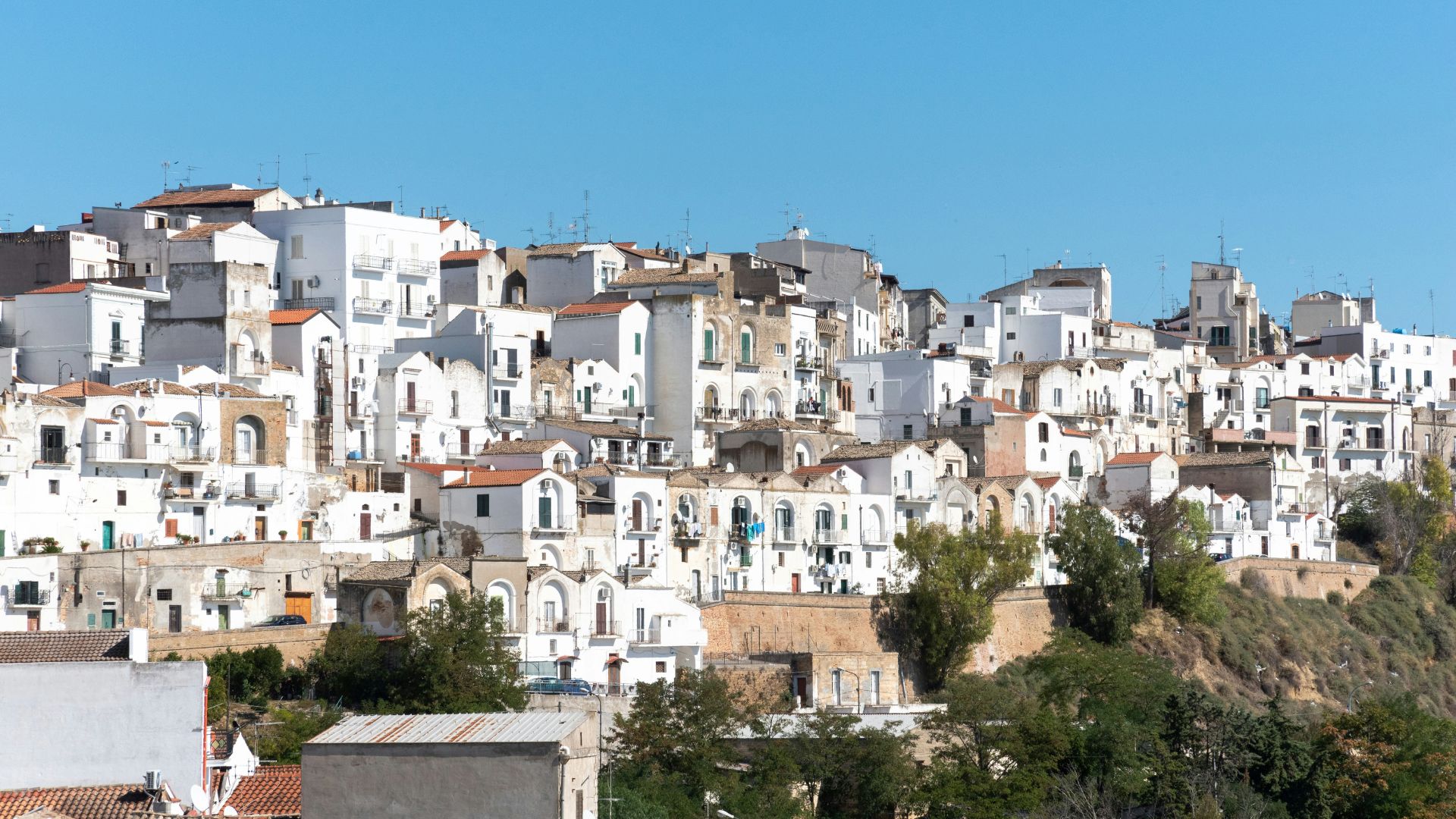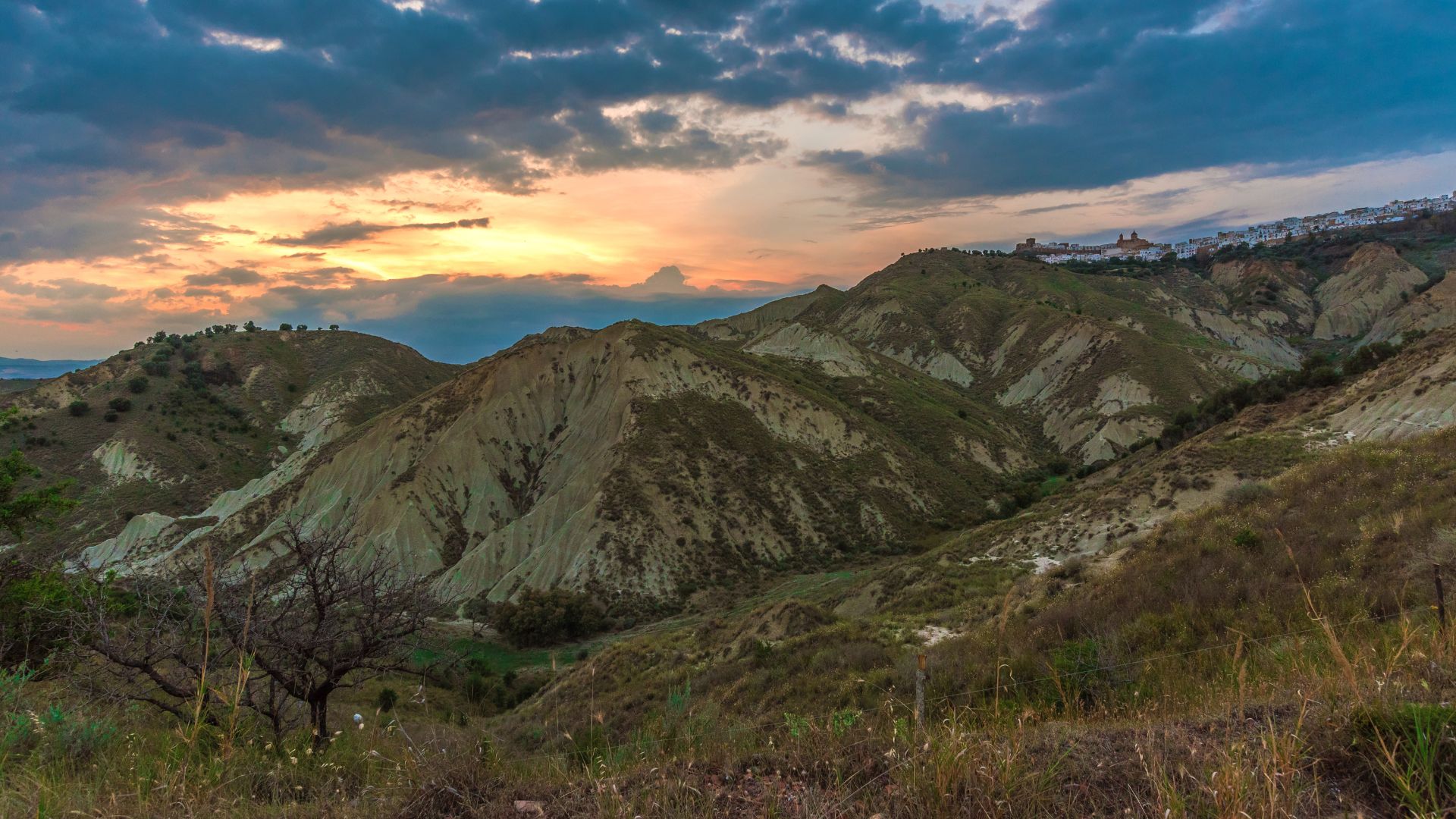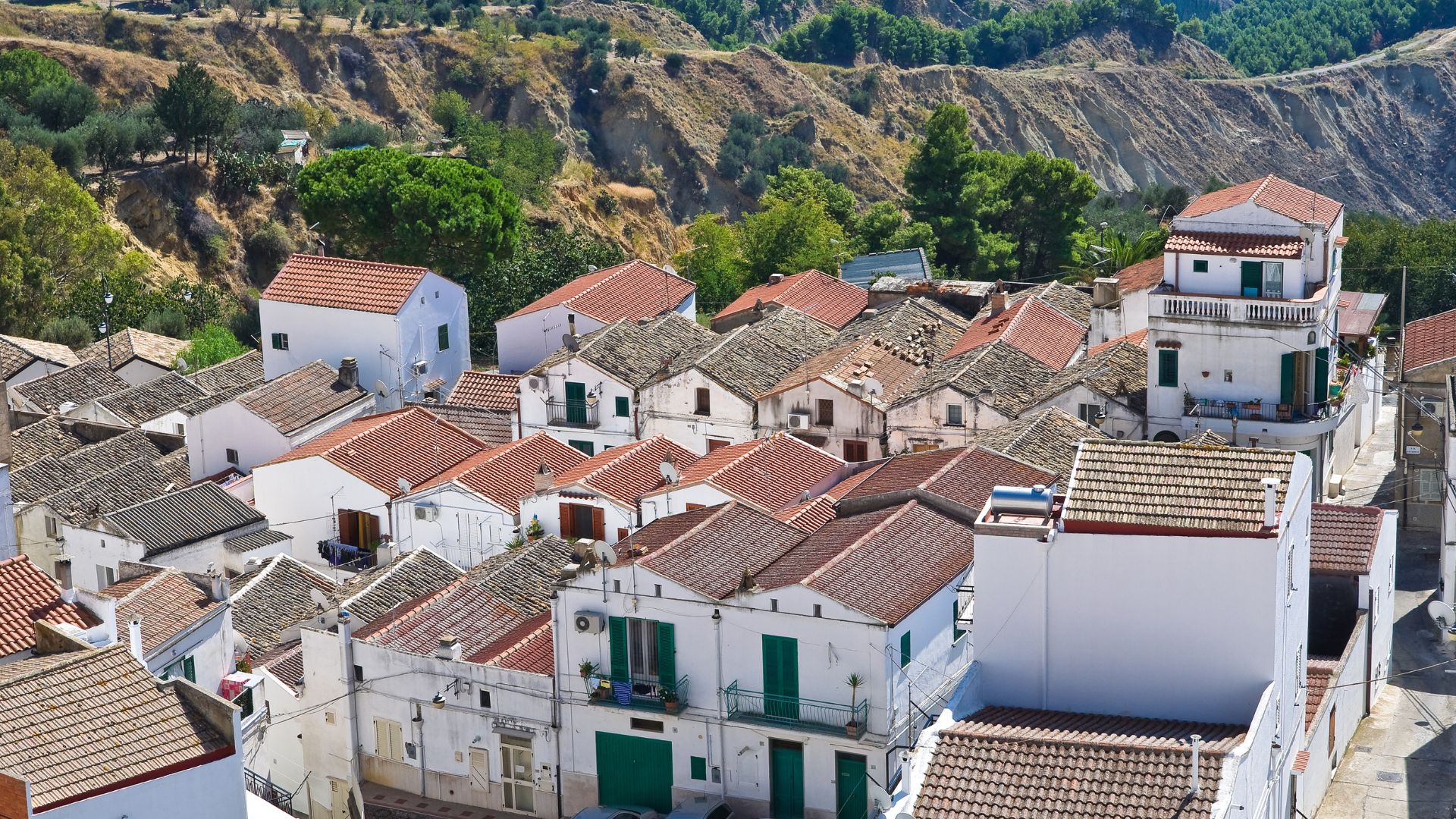Pisticci sits perched on a hilltop in southern Italy’s Basilicata region, grabbing your attention with those brilliant white houses and their terracotta red roofs. When I first spotted the town from miles away, the white buildings popped against the reddish earth of the badlands below.
Locals call it “the white city,” and honestly, it’s one of Italy’s most photogenic places. Homes line up in neat rows along the ridge, creating a landscape that’s hard to forget.
Walking through Pisticci feels like you’ve wandered into a postcard. The houses don’t sprawl out at random—they follow long, organized lines known as “Dirupo.” This rare layout makes the town feel both orderly and a little surreal.
People didn’t just build this way for looks. The hilltop spot kept residents safe from the malaria that once haunted the lowlands and helped defend against invaders.
What really gets me is how Pisticci changes as the light shifts. Mornings bring a gentle glow to the white walls, and by sunset, the whole place is drenched in golden-red light that matches those rooftops.
Beyond the town, Pisticci’s territory stretches toward the coast. There, you’ll find white sandy beaches, perfect for anyone who wants a mix of culture and a little time by the sea.

The Unique Architecture of Pisticci’s White Houses
Wandering Pisticci is like stepping into a painting. Bright white homes rest dramatically on red earth hills.
These houses tell stories of survival, creativity, and community in Basilicata’s tough landscape.
Origins and Historical Development
The white houses go back to the 17th century, after a massive landslide in 1688 wiped out much of the original town. Locals rebuilt with safety in mind, using old techniques passed down through families.
They lined up the houses along the hillside in patterns called “a schiera” (in rows). When I saw them for the first time, I finally got why people call it “the white city.”
The white color isn’t just for show. Whitewashing became a yearly tradition, with families slapping on fresh lime to protect the houses from the harsh southern sun. It keeps the interiors cool, too.
Limestone Structures and Their Significance
Pisticci’s homes owe their brilliance to local limestone, used for both building and finishing. This stone brings some real perks:
- Durability – The houses stand up well to weather and erosion.
- Temperature regulation – Interiors stay cool in summer, warm in winter.
- Fire resistance – Pretty important when homes pack together on a hill.
- Pest deterrence – The alkaline lime keeps bugs at bay.
I was surprised by the thickness of the limestone walls—sometimes more than 24 inches. Step inside on a hot day, and you’ll feel the temperature drop.
The red terracotta roofs really set off the white walls. It’s a combo that’s become iconic for Pisticci, popping up in photos all over the place.

Square Layouts and Urban Planning
Pisticci’s urban design stands out for its mathematical neatness. The houses have square or rectangular footprints, arranged in tight rows that hug the hillside.
This layout didn’t happen by accident. Builders wanted to spread the weight out over the unstable clay soil.
Most homes have:
- Two or three stories
- Simple rectangular windows
- Exterior stairs
- Small balconies facing the valley
Narrow alleys, or “calanchi,” wind between the houses. They serve as natural drains during those rare heavy rains.
From below, the uniform houses create a mesmerizing rhythm.
The design encourages neighbors to gather in shared spaces. I’ve watched people come out in the evenings, escaping the heat indoors and chatting under the stars.

Exploring the Red Earth: Natural Scenery and Geography
Pisticci’s landscape gets its character from the red clay terrain. That bold contrast with the white buildings draws travelers from all over Italy.
Red Earth’s Geological Features
The badlands, or “calanchi,” steal the show around Pisticci. Water erosion over centuries shaped these dramatic clay formations.
Walking here feels otherworldly.
The red clay’s iron oxide gives it that rusty color. When the rains come, the ground can get unstable fast.
Local farmers have figured out how to work with this tough land, growing wheat and olives where the soil holds firm.
The badlands form a crazy maze of ridges and valleys. As the sun moves, the colors shift, and by sunset, the ground glows with an unreal reddish-orange.

Pisticci’s Inland Landscape
Head inland, and the land softens into rolling hills. I’ve spent hours on these paths, stumbling on small farms and hidden vineyards.
The town perches right on the edge of steep clay cliffs. That wasn’t just for the views—it helped keep malaria at bay.
From up here, you can catch sweeping views across Basilicata. On a clear day, the Ionian Sea shimmers in the distance.
Ancient olive groves dot the hills, their twisted trunks hinting at centuries of history.

Nearby Natural Wonders: Castelmezzano and More
If you drive two hours from Pisticci, you’ll reach Castelmezzano—a village clinging to the rocks of the Lucanian Dolomites.
The drive alone is a wild ride, winding through Basilicata’s changing scenery.
For thrill-seekers, Castelmezzano has the “Flight of the Angel,” a zipline that sends you flying between mountain peaks at crazy speeds. I’ll never forget the wind and those insane valley views.
The Gallipoli Cognato National Park nearby offers great hiking, with forests and mountain ridges. You’ll spot all sorts of birds and wildflowers blooming against the red soil.
Capturing Pisticci: Images, Photos, and Visual Inspiration
Those white houses with red roofs, set against the eroded clay hills, make Pisticci a dream for photographers.
The town’s unique look offers endless chances for memorable shots.
Photography Hotspots and Tips
You’ll find the best views in the Dirupo district, where the white houses line up perfectly.
I’ve noticed that early mornings or late afternoons bathe the facades and roofs in golden light—ideal for photos.
For dramatic shots, head to the eastern viewpoint just outside town. From there, the whole settlement sprawls across the hilltop.
Don’t skip the narrow alleys, where laundry sometimes hangs overhead, adding splashes of color.
A telephoto lens compresses the layers of houses, while a wide-angle brings in the vast landscape. In spring, wildflowers make perfect foregrounds.

Stock Photos, Editorial, and Exclusive Collections
Getty Images has a huge collection of Pisticci photos—over 1,300 shots from aerial views to close-up street scenes.
Many photographers curate editorial collections that highlight the white buildings against the red earth.
If you’re after stock images, look for:
- Aerial shots of the historic center
- Architectural close-ups
- Panoramic town views
- Seasonal scenes, especially at sunset
The best collections capture how people live “on the edge” in these cliffside homes, adding a human touch to the beauty.

Videos and Illustrations from Contributors
Local creators have put together stunning time-lapse videos that show how the light changes over Pisticci during the day.
Drone footage has taken off lately, giving us jaw-dropping aerial views of those perfectly lined-up houses.
Artists and illustrators love Pisticci’s geometric patterns and bold contrasts. Watercolor paintings often highlight the terracotta roofs against the white walls.
For video, I’d suggest:
- Morning shots with mist in the valleys
- Evening scenes as the lights come on in the houses
- Slow pans that reveal the whole settlement

Selecting the Perfect Resolution and Orientation
For wide shots of the hillside town, landscape orientation works best. It fits the long row of houses perfectly.
Use portrait orientation for those tight streets or vertical elements like church towers.
If you’re printing, go for high-res images (at least 300 dpi). The textures of the white walls and red roofs deserve that level of detail.
For social media, mix it up—landscape for Facebook and Twitter, square for Instagram feeds, and vertical for Stories or Pinterest.

The Cultural and Archaeological Tapestry of Pisticci
Pisticci’s story goes way beyond its white houses. The area is full of archaeological treasures and ancient connections that give the town real depth.
Linking Pisticci to Ancient Figures: Eos, Ovid, and Myron
As I wander through Pisticci, I keep bumping into reminders of its mythological past. Folks here say the region links to Eos, the Greek goddess of dawn. Honestly, it makes sense—those golden sunrises feel almost divine.
Digging into local stories, I found that Ovid, the Roman poet, supposedly mentioned this area. His words about southern Italy’s rugged beauty hit home when you see Pisticci for yourself.
Myron, the famous ancient Greek sculptor, left his mark here too. You can spot his influence in the town’s love for clean lines and balanced forms, both in the architecture and the arts.
Archaeological Excavations and Antiquities
The land around Pisticci keeps revealing new secrets. Archaeologists have uncovered artifacts that show people have lived here since prehistoric times.
Recent digs turned up Greek pottery and Roman coins, proving this place was an ancient crossroads.
If you visit, check out the excavation sites—layers of history are visible right in the earth, marked by different soil colors against the red clay.
Local museums display all sorts of finds:
- Greek vases and pottery
- Roman household goods
- Ancient farming tools
- Jewelry and ornaments

National Archaeological Museum and Notable Statues
The National Archaeological Museum sits just nearby and showcases the most important finds from the Pisticci area.
I wandered through the collection for hours, honestly losing track of time as I admired artifacts from different centuries.
Several statues stole the show. These pieces highlight the artistic skill of ancient craftspeople.
My personal favorite? A marble figure from around the 3rd century BCE. You can see the Greek influence in its design.
The museum lays out its exhibits in chronological order. That approach helped me understand how Pisticci and the surrounding region changed over time.
I appreciated the English information cards—they made things a lot easier for visitors like me.
Don’t skip the special gallery focused on funerary art. You’ll find haunting terracotta masks and ceremonial objects there.
These pieces offer a surprisingly intimate look at the beliefs and traditions of people who once lived in this striking landscape.
Adventures and Activities Around Pisticci
Pisticci gives visitors a nice mix of relaxation and adventure.
The landscapes around town call out to outdoor lovers, while nearby towns tempt you with cultural discoveries.
Outdoor Experiences and Rafting
The natural scenery around Pisticci turns into a playground for anyone craving adventure.
One day, I tried rafting on the Basento River. The clear water winds through dramatic red clay canyons, and let me tell you, the views are wild.
Local guides led the trip and took safety seriously, so even beginners like me felt comfortable.
If you love hiking, you’ll want to check out the trails through the calanchi—the badlands.
Those white clay ridges against the red earth make the place look almost lunar, and it’s a dream for photographers.
Mountain biking’s catching on around here, too.
You can rent a bike in town and hit marked trails, whether you want a gentle ride through olive groves or a tougher climb in the hills.
Exploring Potenza and Nearby Towns
Potenza is Basilicata’s capital, and honestly, it makes a great day trip from Pisticci. I found myself wandering its medieval center, weaving through those narrow, winding streets, and stopping to admire the striking San Gerardo Cathedral.
You’ll notice the city sits way up, nearly 2,700 feet above sea level. That makes it Italy’s highest regional capital, which is kind of wild if you think about it.
Hop on the old Santa Lucia escalator system while you’re there. It’s one of the longest in Europe, and honestly, it’s a fun (if slightly quirky) way to get around.
Craco sits about an hour’s drive from Pisticci. This ghost town clings to a hillside, and after landslides in the 1960s, everyone had to leave.
The place looks frozen in time, and the ruins feel both eerie and beautiful.
Then there’s Matera, famous for its ancient cave dwellings. If you take a guided tour of the historic center, you’ll see how people managed to live in those stone homes for centuries.
It’s honestly hard not to be amazed by it all.


